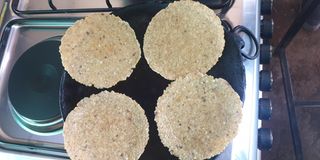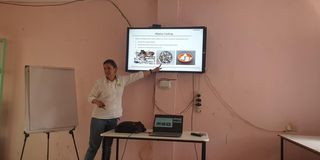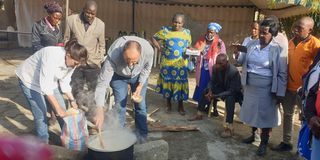Premium
Mexicans teach Kenyans more exciting ways of cooking maize

Mexican Ambassador to Kenya Erasmo Martinez and Seed Savers Director Daniel Wanjama preparing a Mexican cuisine.
The mention of maize brings to mind its different uses in Kenya as an ingredient for ugali, githeri (mixture of maize and beans) and porridge, and as food eaten boiled or roasted.
Because it is the most consumed foodstuff, its availability is often taken as a sign of food security, while lack of it results in fears of food shortages.
While most Kenyan communities use maize as food almost the same way, efforts are underway to widen the ways of consuming this grain.
On a Wednesday evening in Elementaita, Nakuru County, people from various parts of the country gathered to learn about nixtamalisation, which means pre-cooking maize with lime (calcium hydroxide).

Tacos made from maize flour.
Used in Mexico for centuries
Although this method has been in use in Mexico for centuries, it is being introduced in Kenya, thanks to the Mexican Embassy in partnership with the International Centre for Maize and Wheat Improvement (CIMMYT), the Tortilla Foundation in Mexico, Seed Savers Network, World Food Programme (WFP) and other organisations and institutions.
At Seed Savers Network, near Lake Elemantaita, over 35 farmers, chefs and agriculturalists gathered to learn about nixtamalisation and how they can explore this technology to diversify the uses of maize as food.
“Nixtamalisation refers to a process of [preparing] maize or other grains in which the grain is cooked in an alkaline solution, usually lime, calcium hydroxide, steeped for some time (30 minutes to 16 hours) and rinsed,” explained Ms Natalia Palacios, a maize quality specialist at CIMMYT.
“The nixtamalised grains can be used as such, milled into a dough or dried and milled into flour.”

Natalia Palacuos of CIMMYT trains participants on nixtamalisation.
Reduces mycotoxins
Besides diversifying ways of using maize, nixtamalisation reduces mycotoxins — including aflatoxins — in the grain by 60 to 70 per cent, thus enhancing food safety.
The nutritional benefits that come with this process include improvements in the bio-availability of protein, niacin or vitamin B3, which prevent drying and cracking of the mouth and skin.
It also increases calcium and phosphorus, which enhance the strength of bones and teeth.
After being taken through a theoretical session, participants were treated to a Mexican meal comprising tacos, whose base was chapatti-like pieces made from maize flour.
In Kenya, the ‘chapatti’ pieces would ordinarily have been made from wheat flour.

Experts lead in practical training on nixtamisation.
Chapatti-like delicacy
“I did not know that maize flour can be turned into dough and produce a chapatti-like delicacy,” said Mr Francis Ngiri, a farmer from Makongo in Gilgil.
From that moment, he added, he would replace part of his family’s wheat consumption with maize as some people in his household suffer stomach upsets after eating wheat, in suspected cases of gluten intolerance.
After tasting the taco delicacy Mexican style, the participants, including visitors from Mexico, had a sumptuous African cuisine lunch. It was not just about learning how things are done in Mexico, but also a taste of Kenyan food.
In the afternoon, the participants were taken “hands-on” through the initial process of nixtamalisation by Ms Palacios and Mr Rafael Mier, founder and director of the Tortilla Foundation.
Water is heated to near boiling point before lime and maize are added while stirring for 20 minutes, until the grain can peel with ease by hand.
The cooking pot is then removed from fire and allowed to cool for between 30 minutes and 16 hours. The grain is then washed while it is rubbed on a sieve.
Milled while still wet
To make dough, the grain is milled while still wet. In Mexico, the dough is referred to as ‘masa’.
The dough can be used to make various products such as tortillas and porridge. It can also be steamed with vegetables or meat and prepared into a type of bread, cookies and crisps, among others.
Alternatively, the maize can be dried and ground to make ugali or any other related foods.
“It is exciting to participate in learning on diversified ways of utilising maize and other grains beyond what we are used to,” said Ms Penina Ngahu, a farmer.

Participants sampling a typical Kenyan meal.
Time-consuming
While nixtamalisation is labour-intensive and time-consuming, Ms Ngahu said she would train her children on it.
As many young people are struggling to find jobs, nixtamalisation could create employment opportunities, said Mr Daniel Wanjama, director of Seed Savers Network.
“Young people can take advantage of emerging technologies to do value addition to grains [and] thus get employment for themselves as well as other people along the value chain,” he said.
Because this technology enhances better nutrition extraction from grains, he said, Kenyans will be healthier and wealthier.





